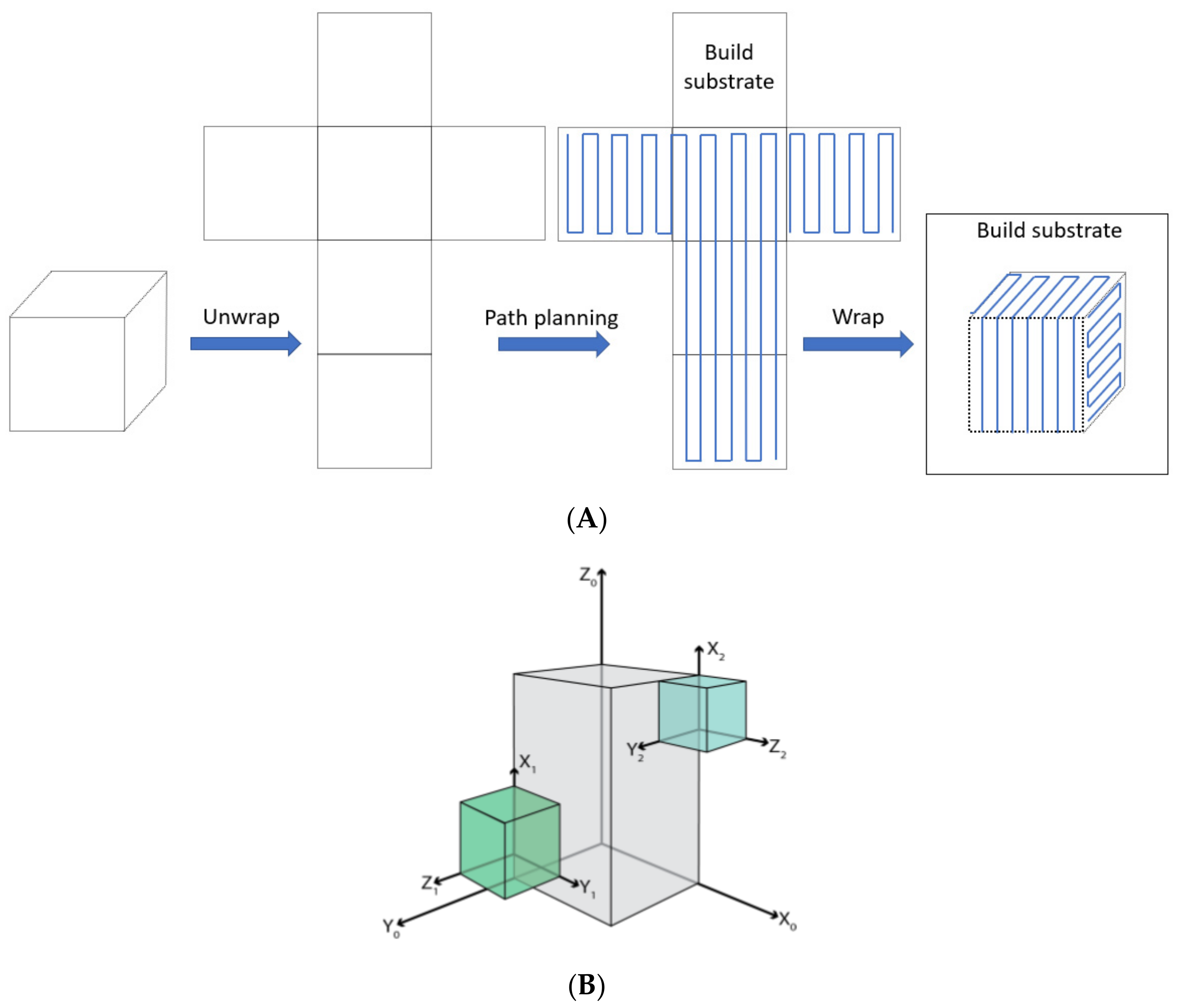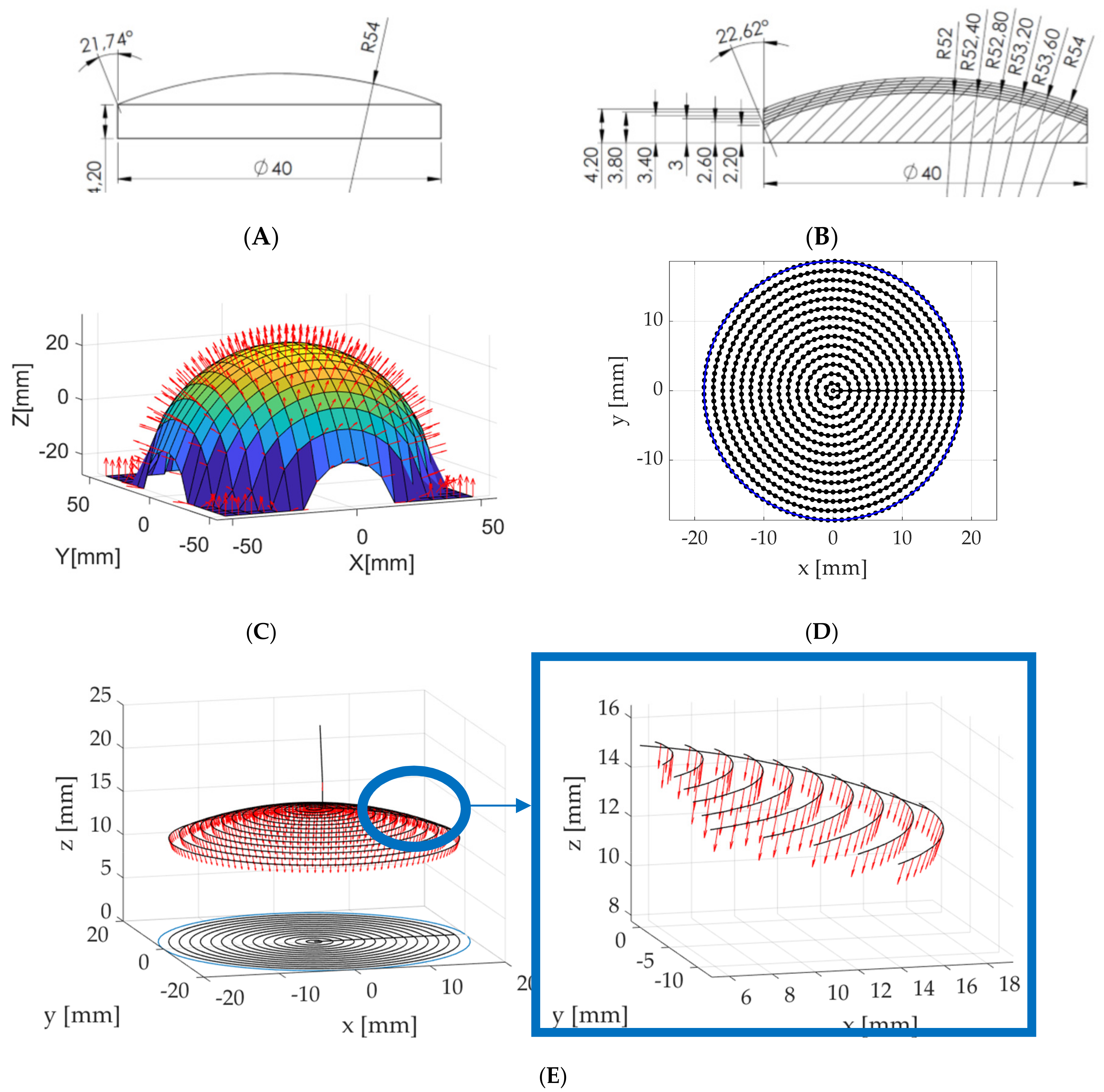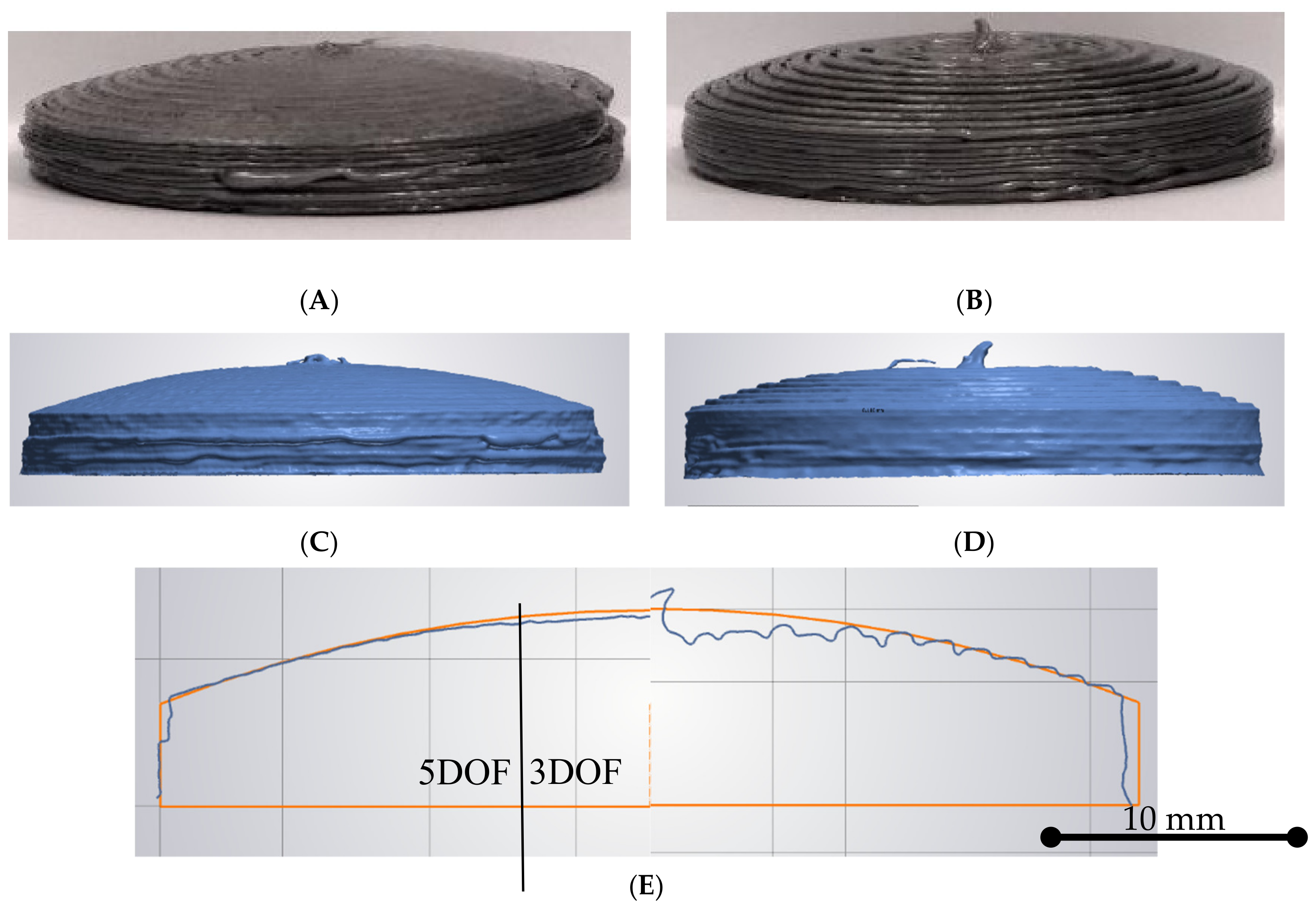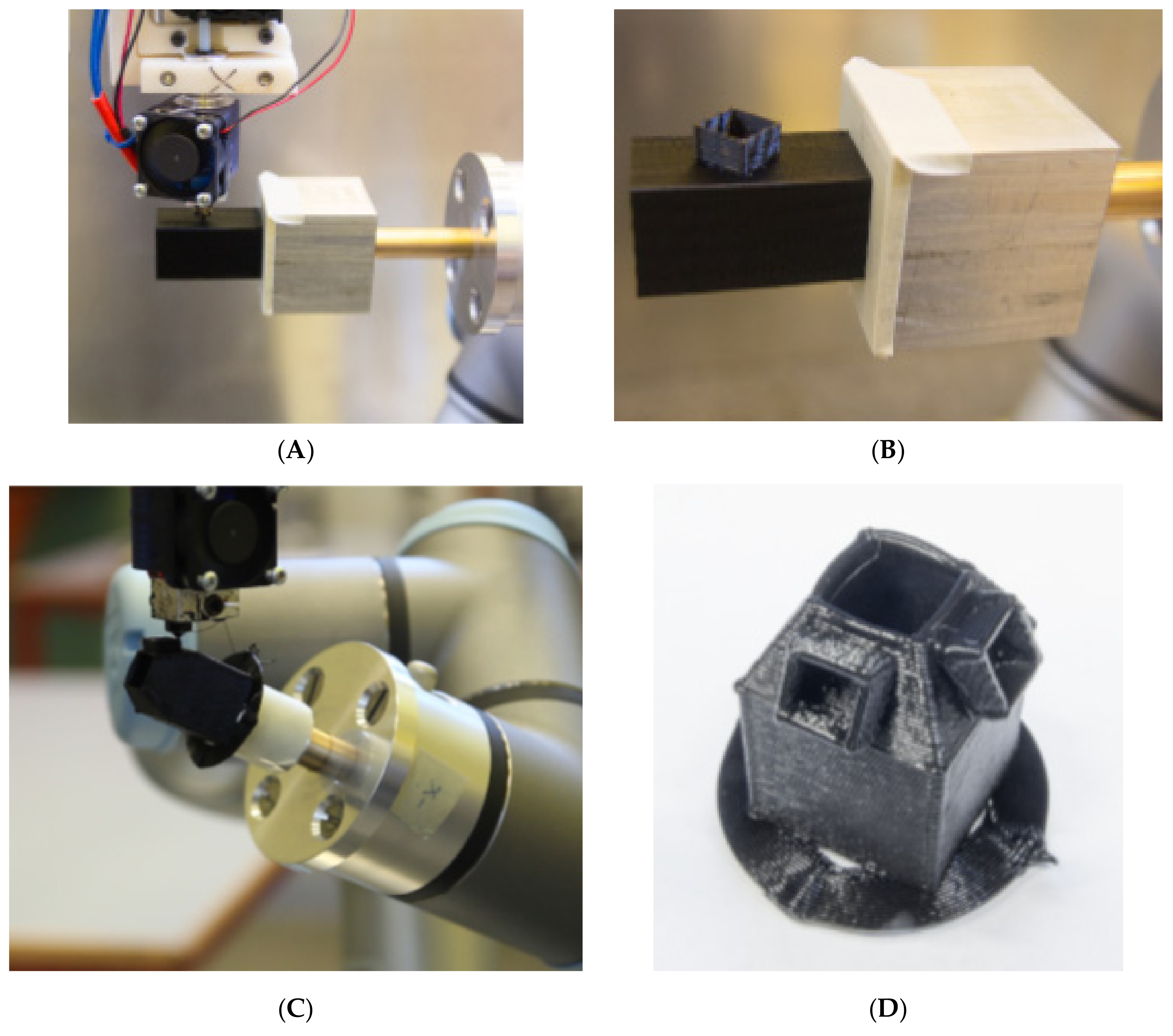Toolpath Strategies for 5DOF and 6DOF Extrusion-Based Additive Manufacturing
Abstract
1. Introduction
2. Methods
2.1. The Tool-Path Projection Approach
2.2. The Parent-Child Approach
3. Implementation
3.1. The Tool-Path Projection Approach
3.2. The Parent-Child Approach
4. Results and Discussion
4.1. The Tool-Path Projection Approach
4.2. The Parent-Child Approach
5. Conclusions
Author Contributions
Funding
Conflicts of Interest
References
- ASTM International. Standard Terminology for Additive Manufacturing–General Principles–Terminology; ASTM International: West Conshohocken, PA, USA, 2015. [Google Scholar]
- Serdeczny, M.P.; Comminal, R.; Pedersen, D.B.; Spangenberg, J. Experimental validation of a numerical model for the strand shape in material extrusion additive manufacturing. Addit. Manuf. 2018, 24, 145–153. [Google Scholar] [CrossRef]
- Pires, J.N.; Azar, A.S. Advances in Robotics for Additive/Hybrid Manufacturing: Robot Control, Speech Interface and Path Planning. Ind. Robot Int. J. 2018, 45, 311–327. [Google Scholar] [CrossRef]
- Singh, P.; Dutta, D. Multi-Direction Slicing for Layered Manufacturing. J. Comput. Inf. Sci. Eng. 2001, 1, 129–142. [Google Scholar] [CrossRef]
- Ding, Y.; Dwivedi, R.; Kovacevic, R. Process Planning for 8-Axis Robotized Laser-Based Direct Metal Deposition System: A Case on Building Revolved Part. Robot. Comput. Integr. Manuf. 2017, 44, 67–76. [Google Scholar] [CrossRef]
- Song, X.; Pan, Y.; Chen, Y. Development of a Low-Cost Parallel Kinematic Machine for Multidirectional Additive Manufacturing. J. Manuf. Sci. Eng. 2015, 137, 021005. [Google Scholar] [CrossRef]
- Pan, Y.; Zhou, C.; Chen, Y.; Partanen, J. Multitool and Multi-Axis Computer Numerically Controlled Accumulation for Fabricating Conformal Features on Curved Surfaces. J. Manuf. Sci. Eng. 2014, 136, 031007. [Google Scholar] [CrossRef]
- Alexander, P.; Allen, S.; Dutta, D. Part Orientation and Build Cost Determination in Layered Manufacturing. Comput. Aided Des. 1998, 30, 343–356. [Google Scholar] [CrossRef]
- Bagsik, A.; Schöppner, V.; Klemp, E. FDM Part Quality Manufactured with Ultem*9085. In Proceedings of the 14th International Scientific Conference on Polymeric Materials, Halle, Germany, 15–17 September 2010. [Google Scholar]
- Quan, Z.; Wu, A.; Keefe, M.; Qin, X.; Yu, J.; Suhr, J.; Chou, T.W. Additive Manufacturing of Multi-Directional Preforms for Composites: Opportunities and Challenges. Mater. Today 2015, 18, 503–512. [Google Scholar] [CrossRef]
- Bourell, D.; Kruth, J.P.; Leu, M.; Levy, G.; Rosen, D.; Beese, A.M.; Clare, A. Materials for Additive Manufacturing. CIRP Annals 2017, 66, 659–681. [Google Scholar] [CrossRef]
- Comminal, R.; Serdeczny, M.P.; Pedersen, D.B.; Spangenberg, J. Numerical Modeling of the Material Deposition and Contouring Precision in Fused Deposition Modeling. In Proceedings of the 29th Annual International Solid Freeform Fabrication Symposium, Austin, TX, USA, 13–15 August 2018. [Google Scholar]
- Comminal, R.; Serdeczny, M.P.; Pedersen, D.B.; Spangenberg, J. Numerical modeling of the strand deposition flow in extrusion-based additive manufacturing. Addit. Manuf. 2018, 20, 68–76. [Google Scholar] [CrossRef]
- Comminal, R.; Serdeczny, M.P.; Pedersen, D.B.; Spangenberg, J. Motion planning and numerical simulation of material deposition at corners in extrusion additive manufacturing. Addit. Manuf. 2019, 29, 100753. [Google Scholar] [CrossRef]
- Serdeczny, M.P.; Comminal, R.; Pedersen, D.B.; Spangenberg, J. Numerical simulations of the mesostructure formation in material extrusion additive manufacturing. Addit. Manuf. 2019, 28, 419–429. [Google Scholar] [CrossRef]
- Marsan, A. A Review of Process Planning Techniques in Layered Manufacturing Prashant Kulkarni. Rapid Prototyp. J. 2008, 6, 18–35. [Google Scholar] [CrossRef]
- Ding, D.; Pan, Z.; Cuiuri, D.; Li, H. A Multi-Bead Overlapping Model for Robotic Wire and Arc Additive Manufacturing (WAAM). Robot. Comput. Integr. Manuf. 2015, 31, 101–110. [Google Scholar] [CrossRef]
- Rea Minango, S.N.; Ferreira, J.C.E. Combining the STEP-NC Standard and Forward and Inverse Kinematics Methods for Generating Manufacturing Tool Paths for Serial and Hybrid Robots. Int. J. Comput. Integr. Manuf. 2017, 30, 1203–1223. [Google Scholar] [CrossRef]
- Zhu, W.; Lee, Y.S. Five-Axis Pencil-Cut Planning and Virtual Prototyping with 5-DOF Haptic Interface. Comput. Aided Des. 2004, 36, 1295–1307. [Google Scholar] [CrossRef]
- Bohez, E.L.J. Five-Axis Milling Machine Tool Kinematic Chain Design and Analysis. Int. J. Mach. Tools Manuf. 2002, 42, 505–520. [Google Scholar] [CrossRef]
- Sarma, E.S. Automatic 5-Axis NC Toolpath Generation; Massachusetts Institute of Technology: Cambridge, MA, USA, 2001. [Google Scholar]
- Jensen, M.L. New Production Paradigms for Wind Turbines. Ph.D. Thesis, Technical University of Denmark, Lyngby, Denmark, 2019. [Google Scholar]
- D’Angelo, G. A Platform for Multi Material Additive Manufacturing, Modular Tooling and Process Verification. Ph.D. Thesis, Technical University of Denmark, Lyngby, Denmark, 2016. [Google Scholar]
- Catmull, E. A Subdivision Algorithm for Computer Display of Curved Surfaces. Ph.D. Thesis, University of Utah, Salt Lake City, UT, USA, December 1974. [Google Scholar]
- CuraEngine, 2019. CuraEngine is a Powerful, Fast and Robust Engine for Processing 3D Models into 3D Printing Instruction. Available online: https://github.com/Ultimaker/CuraEngine (accessed on 4 October 2019).
- Lee, K.; Jee, H. Slicing Algorithms for Multi-Axis 3-D Metal Printing of Overhangs. J. Mech. Sci. Technol. 2015, 29, 5139–5144. [Google Scholar] [CrossRef]
- Jensen, M.L.; Kiewning, M.K.; Spangenberg, J.; Andersen, S.B.; Pedersen, D.B.; Hansen, H.N. A 5D Dof Parralel Kinematic Controller for Big Area Additive Manufacturing. In Joint Special Interest Group Meeting between Euspen and ASPE Dimensional Accuracy and Surface Finish in Additive Manufacturing 2018; American Society for Precision Engineering: Berkeley, CA, USA, 2018. [Google Scholar]
- ROS.Org. n.d. ROS.Org|Powering the World’s Robots. Available online: http://www.ros.org/ (accessed on 3 December 2018).
- MoveIt. n.d. Moving Robots into the Future. Available online: http://moveit.ros.org/ (accessed on 7 November 2018).





© 2019 by the authors. Licensee MDPI, Basel, Switzerland. This article is an open access article distributed under the terms and conditions of the Creative Commons Attribution (CC BY) license (http://creativecommons.org/licenses/by/4.0/).
Share and Cite
Jensen, M.L.; Mahshid, R.; D’Angelo, G.; Walther, J.U.; Kiewning, M.K.; Spangenberg, J.; Hansen, H.N.; Pedersen, D.B. Toolpath Strategies for 5DOF and 6DOF Extrusion-Based Additive Manufacturing. Appl. Sci. 2019, 9, 4168. https://doi.org/10.3390/app9194168
Jensen ML, Mahshid R, D’Angelo G, Walther JU, Kiewning MK, Spangenberg J, Hansen HN, Pedersen DB. Toolpath Strategies for 5DOF and 6DOF Extrusion-Based Additive Manufacturing. Applied Sciences. 2019; 9(19):4168. https://doi.org/10.3390/app9194168
Chicago/Turabian StyleJensen, Mathias Laustsen, Rasoul Mahshid, Greta D’Angelo, Jeppe U. Walther, Malte K. Kiewning, Jon Spangenberg, Hans Nørgaard Hansen, and David Bue Pedersen. 2019. "Toolpath Strategies for 5DOF and 6DOF Extrusion-Based Additive Manufacturing" Applied Sciences 9, no. 19: 4168. https://doi.org/10.3390/app9194168
APA StyleJensen, M. L., Mahshid, R., D’Angelo, G., Walther, J. U., Kiewning, M. K., Spangenberg, J., Hansen, H. N., & Pedersen, D. B. (2019). Toolpath Strategies for 5DOF and 6DOF Extrusion-Based Additive Manufacturing. Applied Sciences, 9(19), 4168. https://doi.org/10.3390/app9194168




